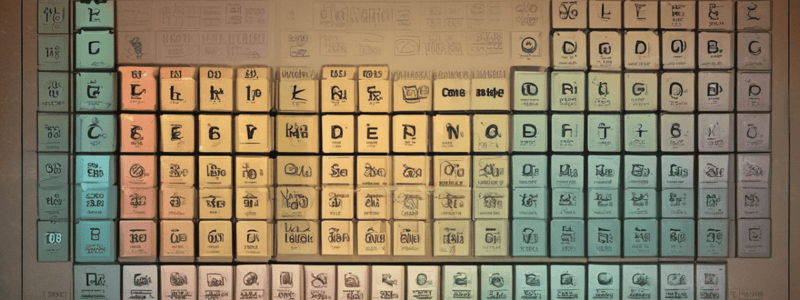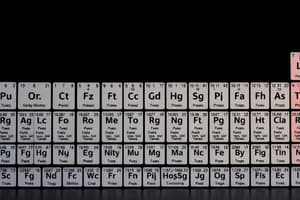Podcast
Questions and Answers
Why does the boiling point of elements tend to increase when moving from left to right across a period until reaching around the middle of the table?
Why does the boiling point of elements tend to increase when moving from left to right across a period until reaching around the middle of the table?
- The strength of metallic bonds decreases from left to right.
- The intermolecular forces of nonmetals increase.
- The metallic character decreases from left to right.
- The strength of metallic bonds increases from left to right. (correct)
Which elements are more likely to have higher boiling points, metals or nonmetals?
Which elements are more likely to have higher boiling points, metals or nonmetals?
- Both metals and nonmetals
- Neither, as boiling points are not influenced by the type of element
- Metals (correct)
- Nonmetals
Why do nonmetals generally have lower boiling points than metals?
Why do nonmetals generally have lower boiling points than metals?
- Nonmetals have stronger metallic bonds.
- Nonmetals are positively charged.
- Nonmetals have weaker intermolecular forces than metallic bonds. (correct)
- Nonmetals are denser than metals.
What is the primary reason for the change in boiling point when moving across a period from metals to nonmetals?
What is the primary reason for the change in boiling point when moving across a period from metals to nonmetals?
How is the strength of metallic bonds related to the boiling point trend within a period?
How is the strength of metallic bonds related to the boiling point trend within a period?
Which type of elements have intermolecular bonds weaker than metallic bonds?
Which type of elements have intermolecular bonds weaker than metallic bonds?
'Diagonal Relationship of elements' is a characteristic related to which aspect of the periodic table?
'Diagonal Relationship of elements' is a characteristic related to which aspect of the periodic table?
'Metallic Character' generally follows which trend on the periodic table?
'Metallic Character' generally follows which trend on the periodic table?
Why does the boiling point of elements decrease sharply when moving from metals to nonmetals within a period?
Why does the boiling point of elements decrease sharply when moving from metals to nonmetals within a period?
What happens to the boiling point of elements as we move from left to right across a period?
What happens to the boiling point of elements as we move from left to right across a period?
Why do many metals have higher boiling points compared to nonmetals?
Why do many metals have higher boiling points compared to nonmetals?
Which group of elements is more likely to exhibit an increase in boiling point across a period?
Which group of elements is more likely to exhibit an increase in boiling point across a period?
What characteristic of nonmetals contributes to their lower boiling points compared to metals?
What characteristic of nonmetals contributes to their lower boiling points compared to metals?
What causes the decrease in boiling point when moving from left to right within a period to the nonmetals section?
What causes the decrease in boiling point when moving from left to right within a period to the nonmetals section?




